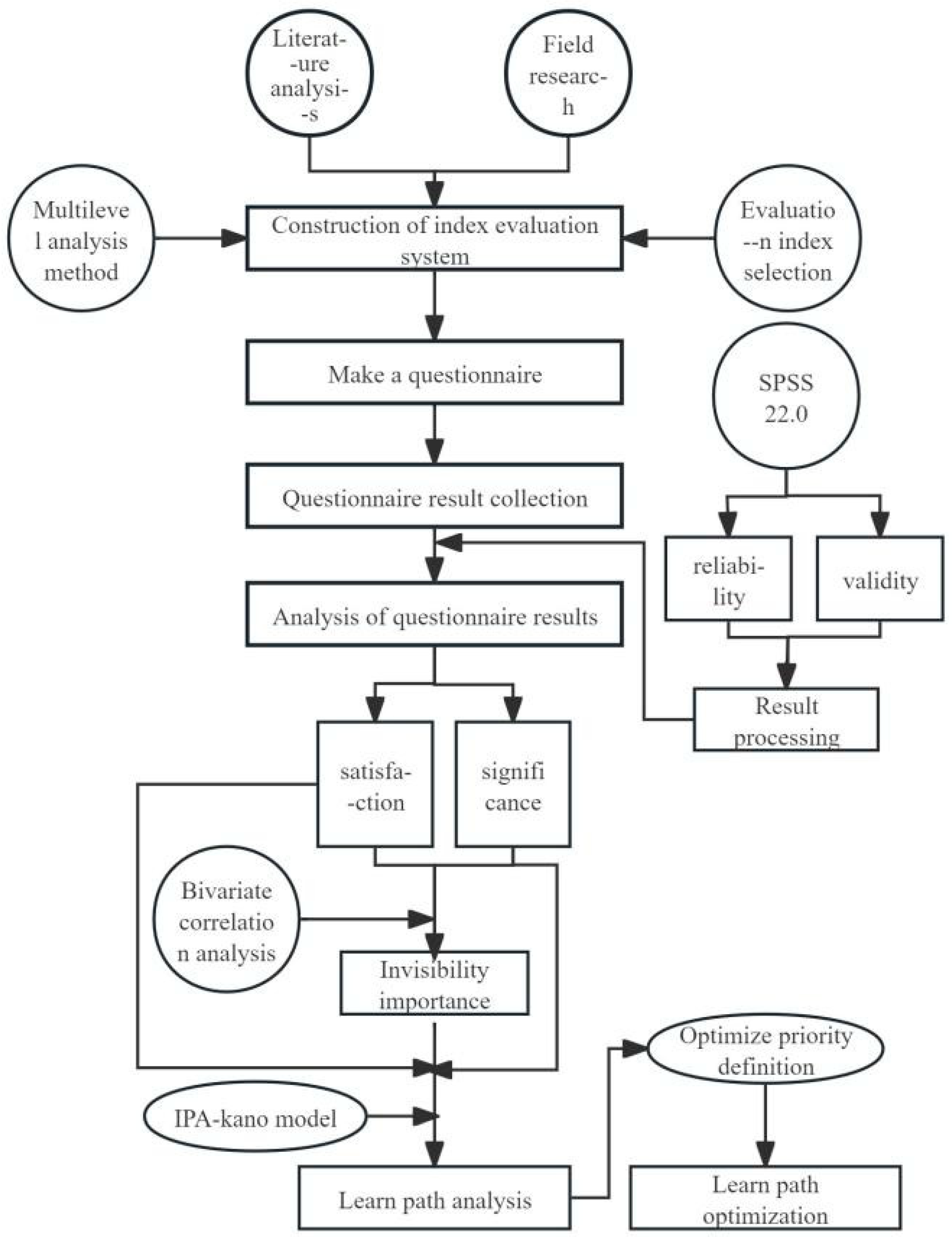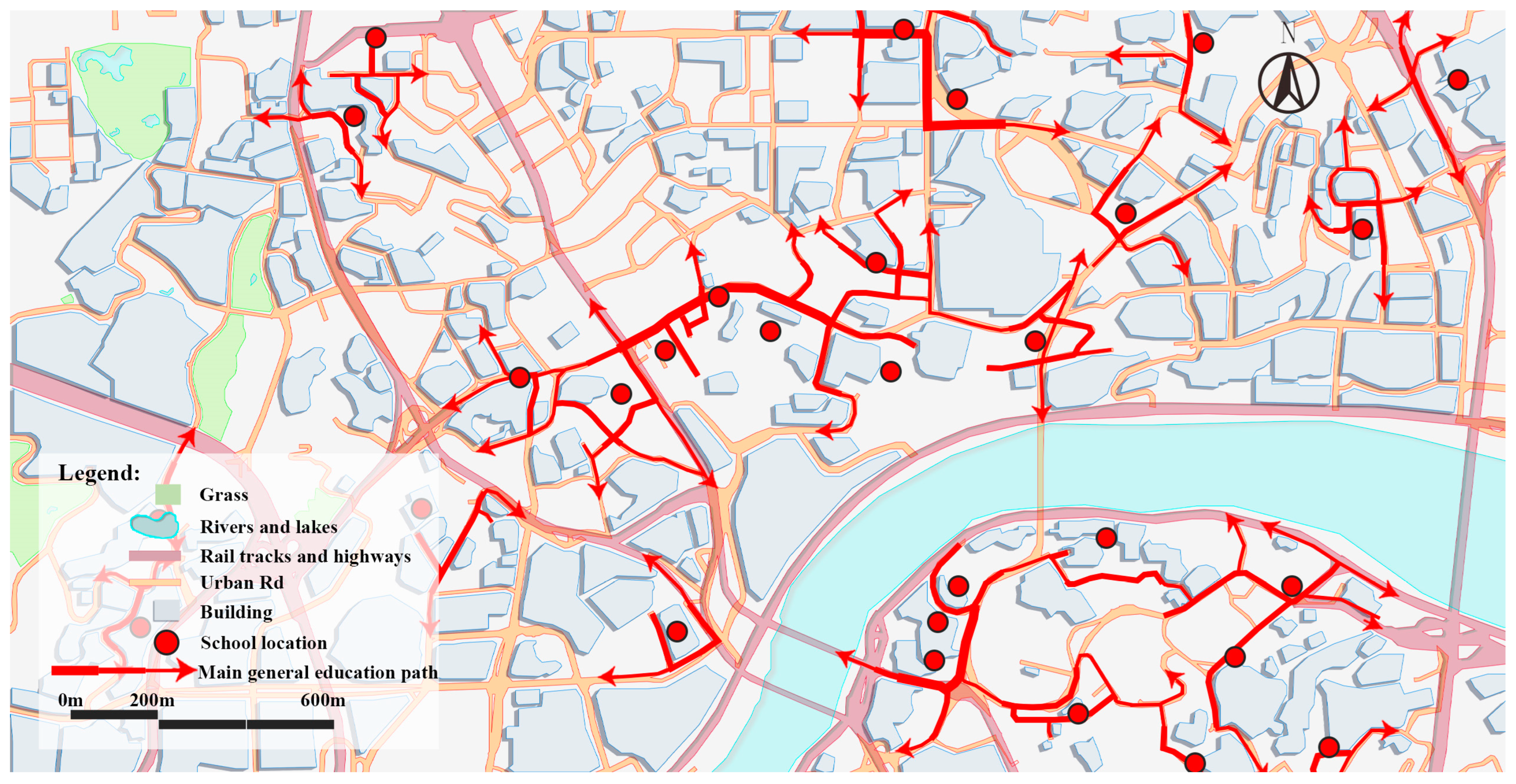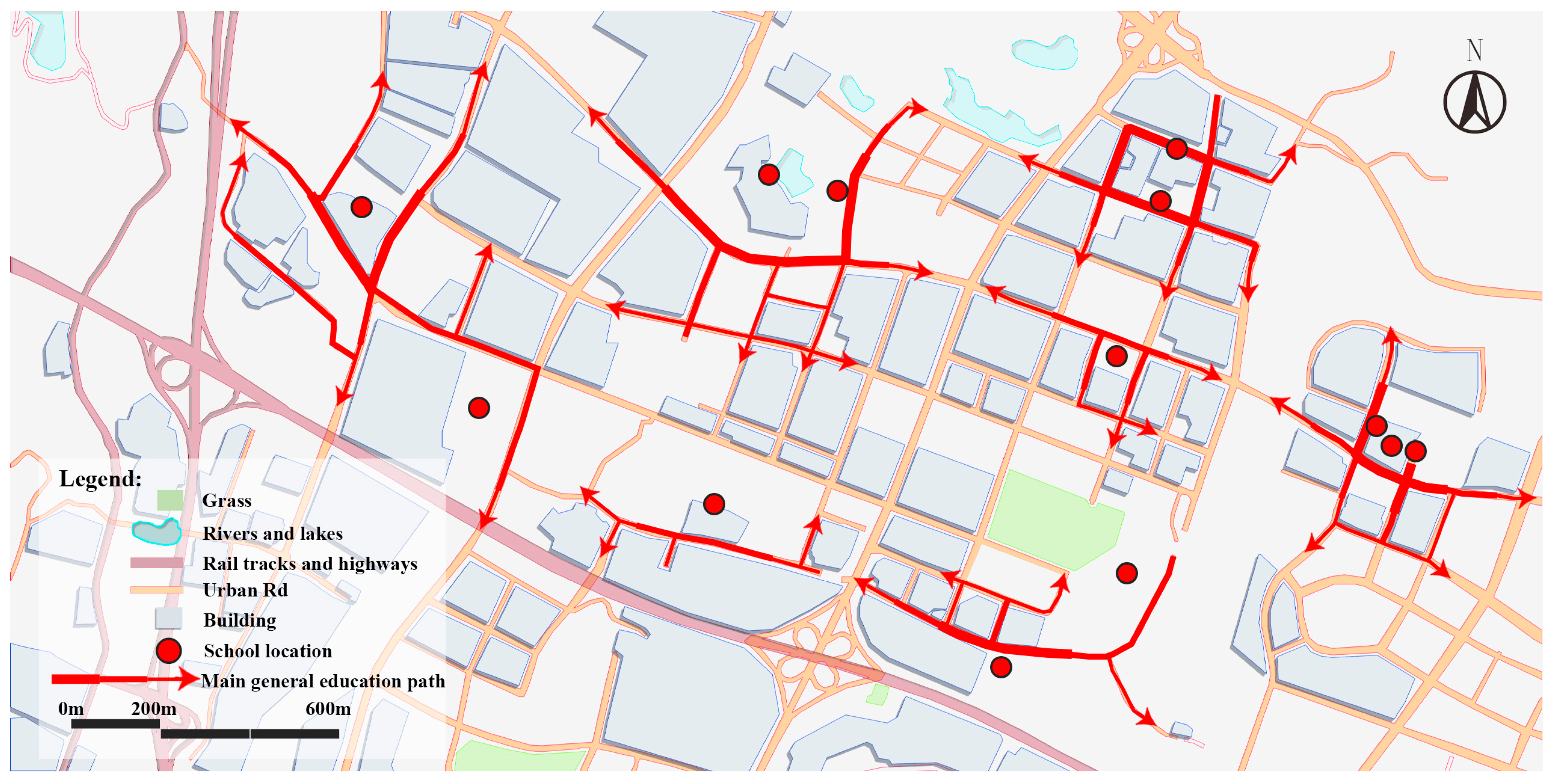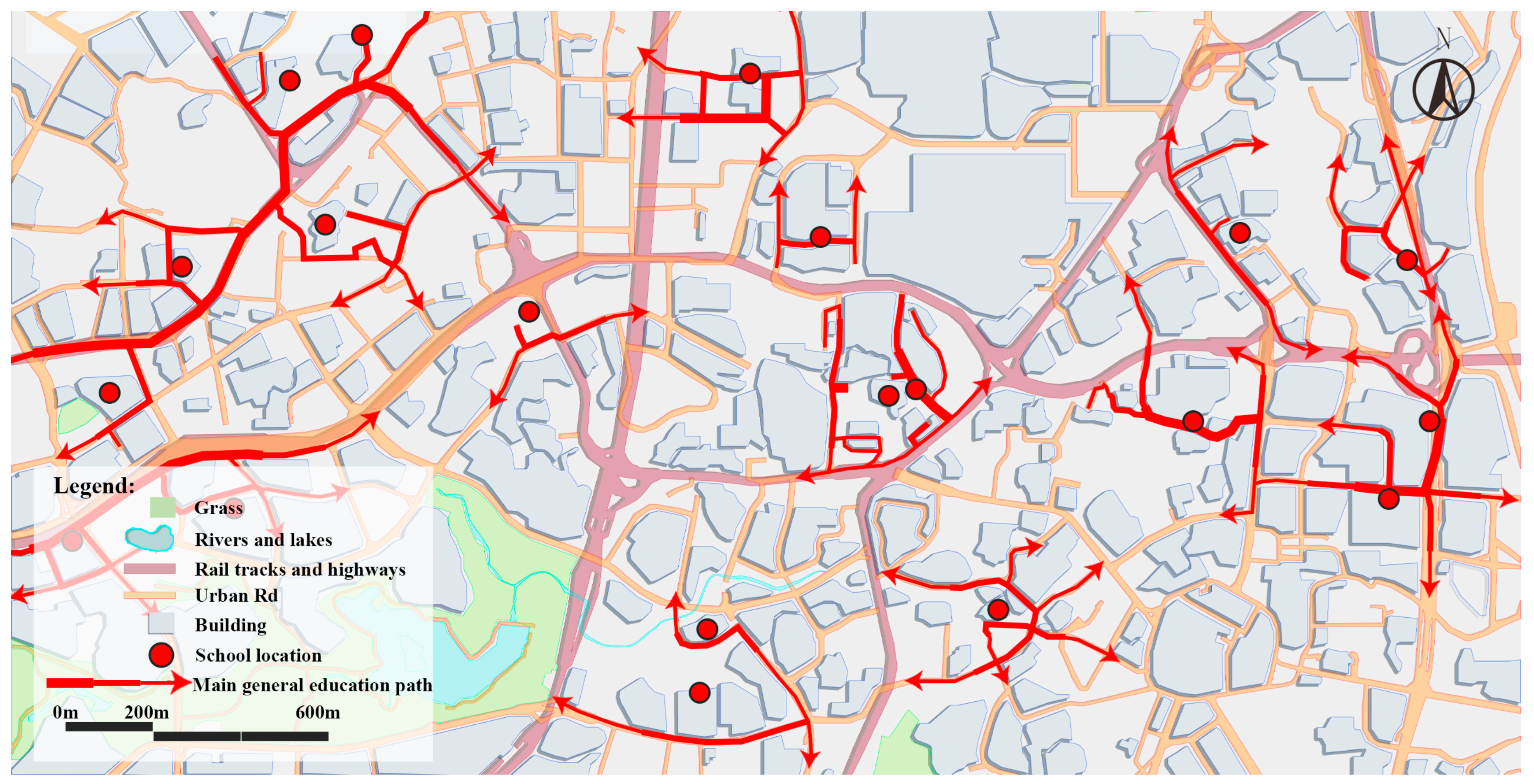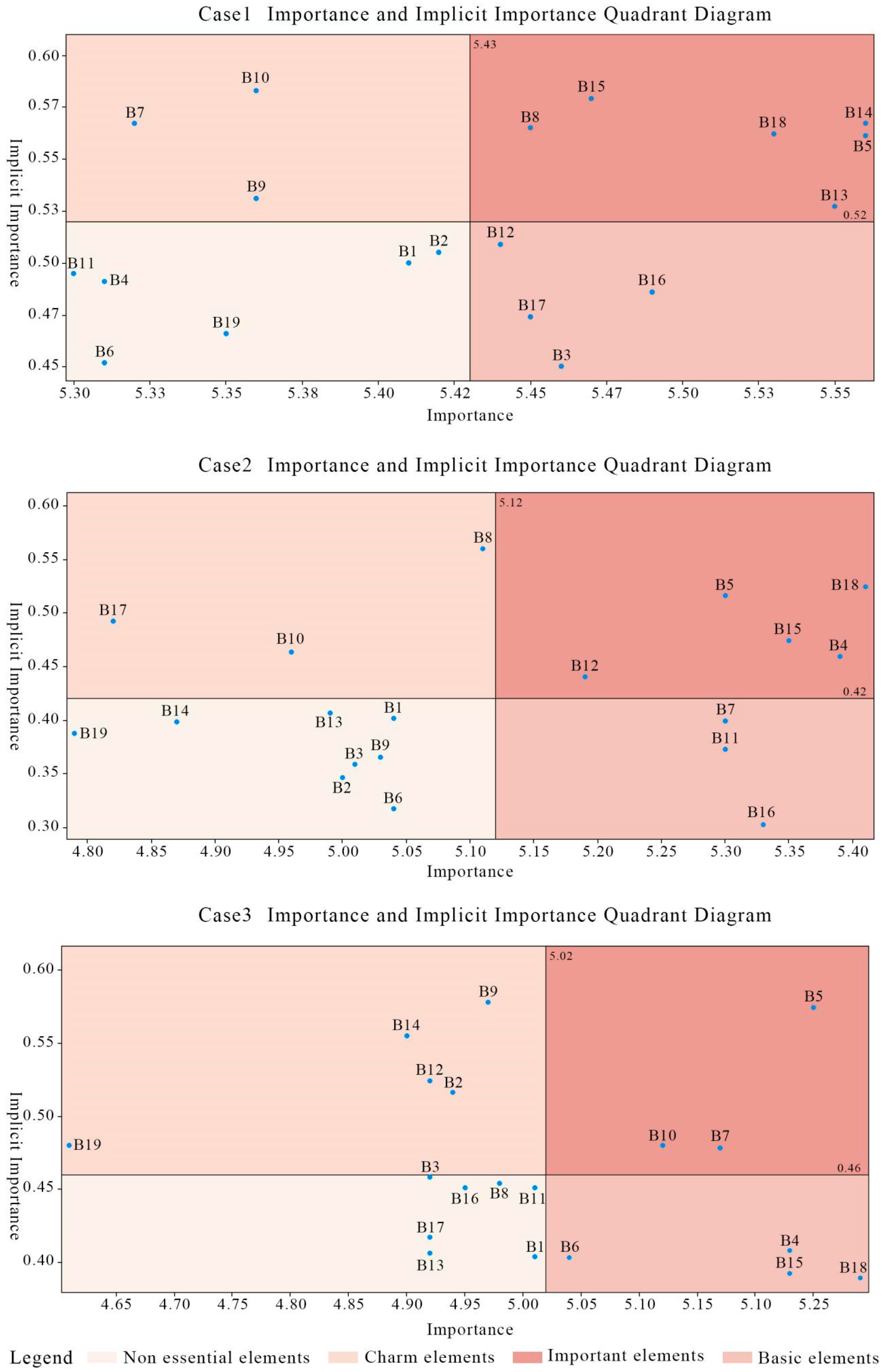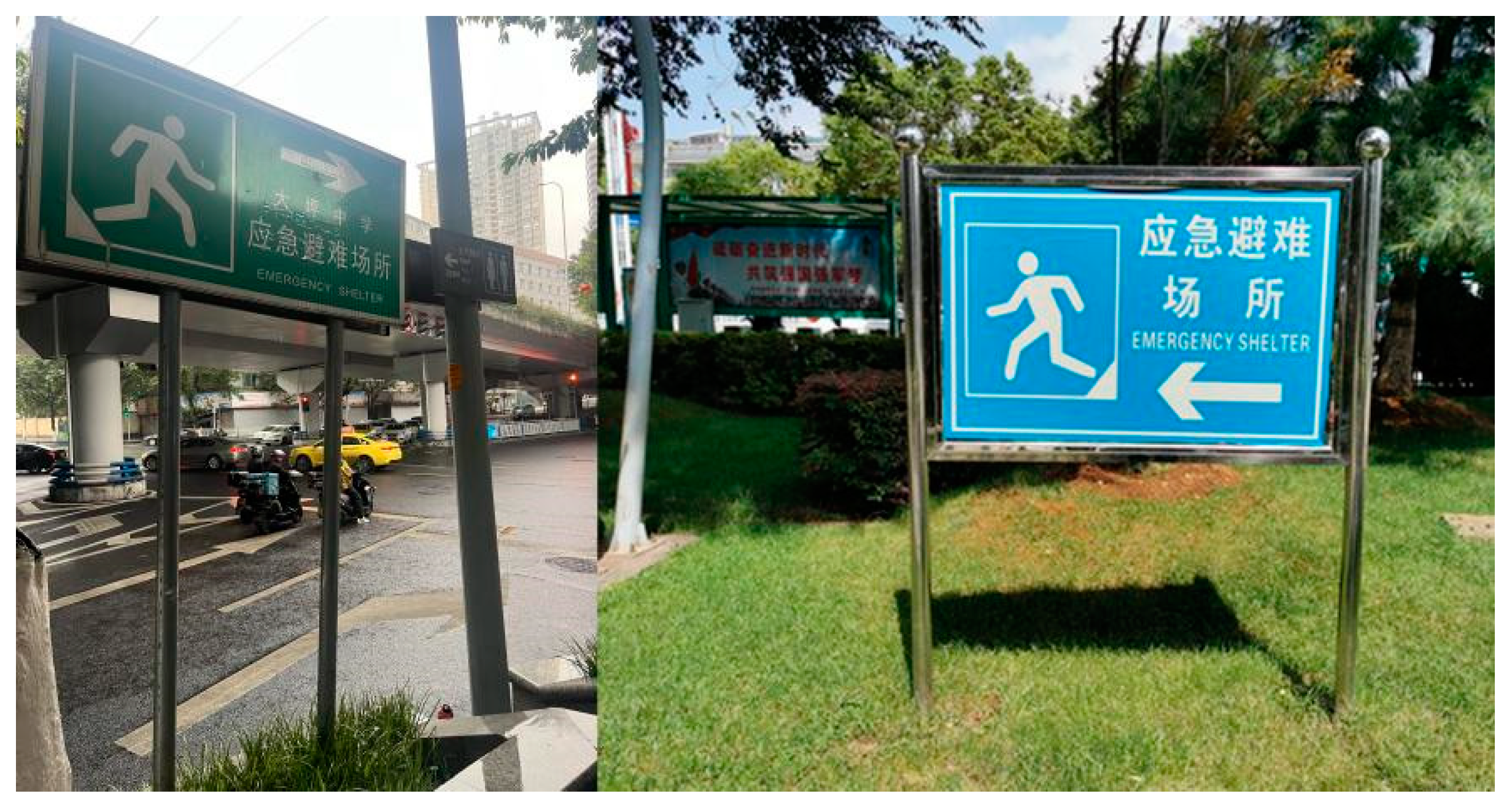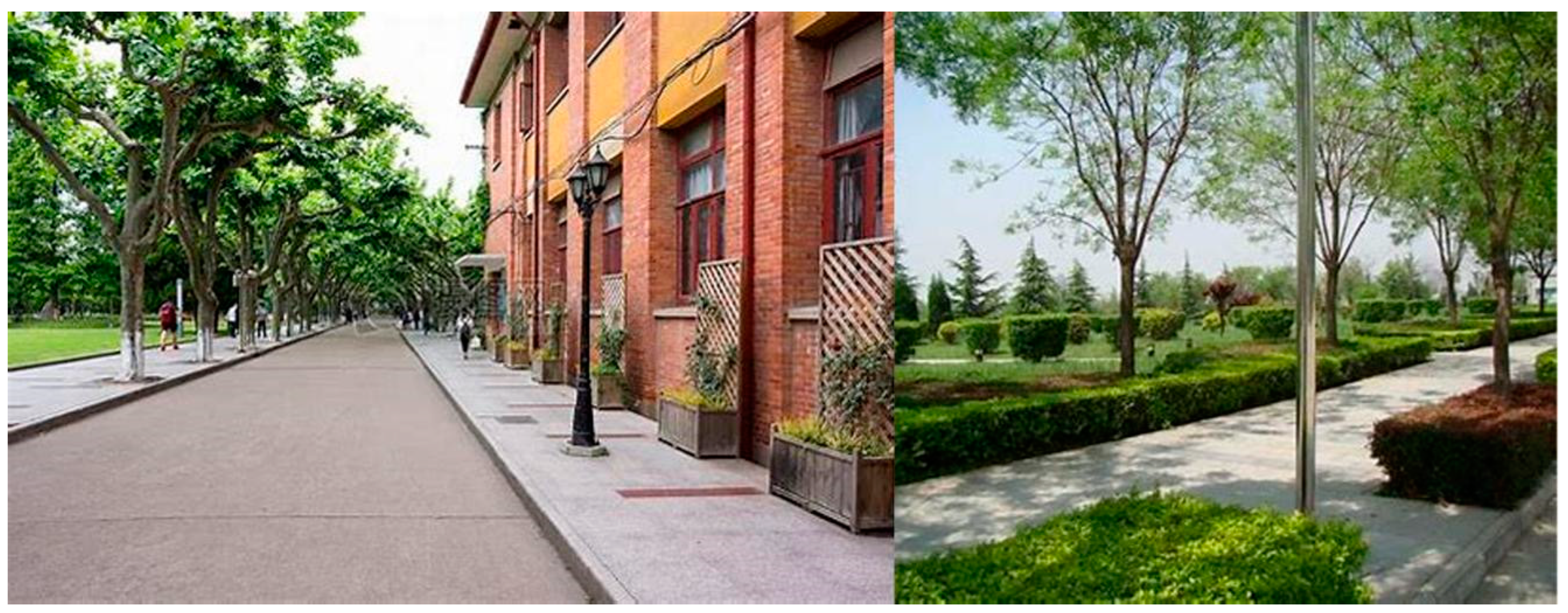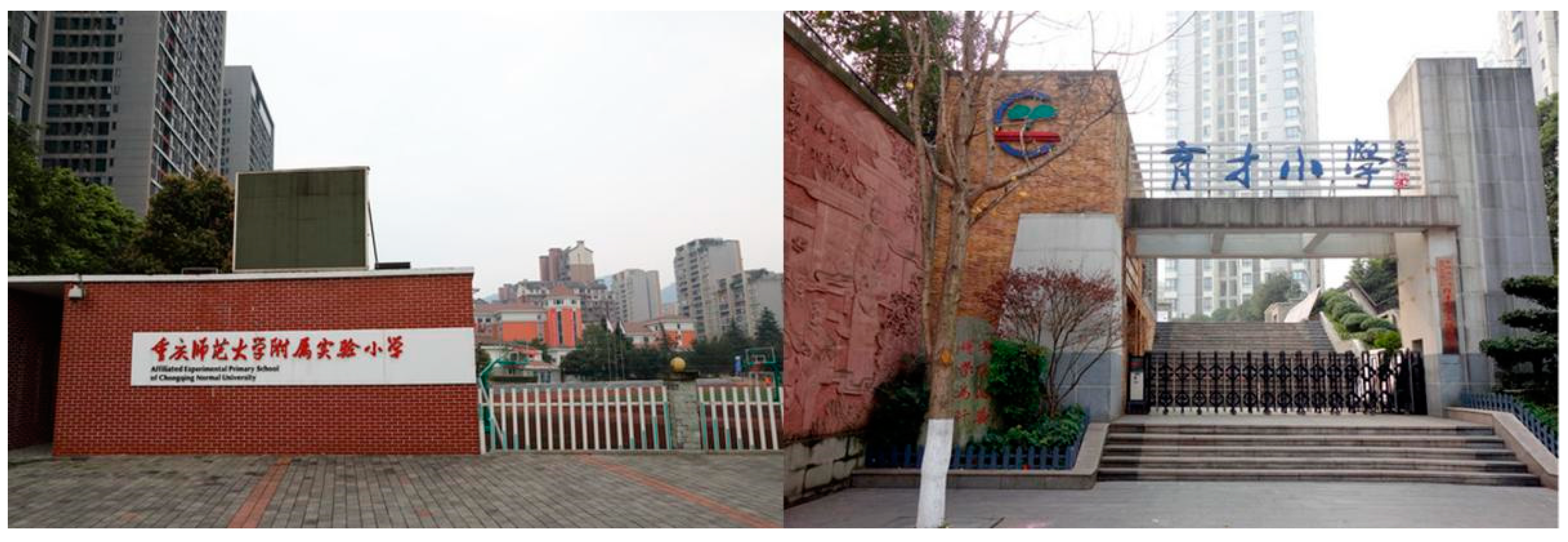1. Introduction
The concept of child-friendliness originates from the United Nations Convention on the Rights of the Child, emphasizing that children should enjoy equal rights to urban spaces as adults during their lives, growth, and development. With the acceleration of global urbanization, children’s living environments face increasingly severe challenges, particularly in highly urbanized settings where they are often marginalized in urban spaces. Public spaces, as open areas for various social interactions, serve as crucial platforms for implementing child-friendly principles and promoting children’s activities. A child-friendly city not only focuses on children’s living conditions but also prioritizes their needs in mobility, recreation, education, and more [
1]. The concept of child-friendliness extends beyond the adaptability of physical environments to include psychological and emotional security and a sense of belonging. Children’s development is deeply intertwined with their surroundings, especially the design and allocation of spaces related to transportation, education, health, and social interaction. By studying child-friendliness, we can gain a deeper understanding of the specific challenges children face in urban life, particularly in terms of traffic safety, accessibility of public facilities, and the allocation of green spaces. Thoughtful urban design can improve children’s physical and mental well-being, mitigate the negative impacts of urbanization, and foster harmonious interactions between children and urban spaces. Therefore, designing child-friendly cities is essential for sustainable human development. Child-friendly cities encourage children to grow up in healthy, safe, and supportive environments [
2].
In contemporary society, parents have placed unprecedented emphasis on the safety and convenience of their children’s school commuting routes. This concern stems not only from a profound interest in the individual growth environment of children but also reflects the proactive aspirations of families, as fundamental units of society, for constructing harmonious and secure community environments. With the continuous advancement of educational philosophy and the widespread enhancement of social safety awareness, an increasing number of parents are scrutinizing and optimizing their children’s school commuting routes, aiming to create a more autonomous and secure environment for them during their commutes. Against this backdrop, exploring how parents, based on meticulous considerations of their children’s school commuting routes, gradually establish trust and assurance in their children’s ability to commute independently, has emerged as a noteworthy educational and sociological research topic. This study aims to analyze parents’ psychological changes, behavioral strategies, and the long-term impact on children’s independence cultivation during this process, in order to provide theoretical support and practical guidance for establishing a more comprehensive child school commuting support system.
With the accelerated urbanization of mountainous regions in China, an emphasis on rapid development at the expense of quality has led to severe urban concentration and irrational spatial distribution. Urban vitality (UV) can aid in identifying and addressing these issues, thereby promoting sustainable urban development, which encompasses street vitality [
3]. Mountainous cities, exemplified by Chongqing, possess unique geographical and urban layouts. Compared to plain cities, mountainous cities confront more complex terrain, transportation, and infrastructure development challenges. These geographical characteristics pose numerous hurdles, particularly in planning school commuting routes for children, where undulating terrain, road congestion, and traffic safety issues become significant factors affecting children’s safety and travel. Researching child-friendly school commuting routes in mountainous cities is a response to and solution for children’s travel problems in this unique urban context. The specificity of mountainous cities necessitates thorough consideration of terrain and the rationality of traffic flow lines in transportation planning. Roads in mountainous cities often feature steep slopes, narrow streets, and poor traffic flow, which may compromise children’s travel safety. The safety issues faced by children during their commutes often extend beyond traffic accidents to include steep roads, unclear traffic signals, and inadequate public facilities. Therefore, designing safe and convenient school commuting routes for children based on the characteristics of mountainous cities is a worthwhile topic for in-depth research. In the construction of child-friendly mountainous cities, attention should not only be paid to solving transportation issues but also to ensuring environmental comfort.
Mountainous cities, characterized by complex terrain, often face challenges such as poor traffic accessibility and steep road slopes, making the safety and convenience of school routes particularly critical for children. Although many cities have recognized the necessity of child-friendly urban planning, the unique characteristics of mountainous cities render traditional urban planning solutions inadequate. Analyzing and optimizing child-friendly school routes in mountainous cities can help identify existing hazards and provide tailored solutions that meet children’s commuting needs, thereby ensuring their safety and well-being. Currently, the design of school routes in mountainous cities lacks specificity, often overlooking the unique topographical features and children’s mobility requirements. For instance, steep slopes, high-traffic roads, and areas lacking sidewalks increase safety risks for children during their commutes. Moreover, traditional urban planning tends to prioritize adult mobility needs, neglecting factors such as children’s height, field of vision, and walking capabilities, leaving significant room for optimization in school route planning. By analyzing and optimizing child-friendly school routes in mountainous cities, more rational traffic organization and scientific spatial layouts can be achieved. Measures such as adding more pedestrian pathways, improving traffic signals, installing child-specific crossing facilities, and optimizing transport hubs can significantly enhance children’s commuting safety. Additionally, optimized school routes not only meet safety requirements but also improve comfort, enhancing children’s commuting experience. Therefore, through scientific analysis and optimization of school routes, the child-friendliness of mountainous cities can be effectively improved, transforming them into more livable, learnable, and enjoyable spaces.
3. Materials and Methods
3.1. IPA-KANO Model
This study introduces the IPA-KANO model to conduct a quantitative analysis of school commuting routes in mountainous cities in Chongqing based on the child-friendly concept [
26]. The IPA (Importance-Performance Analysis) model, originally proposed by Martilla and James, aims to identify factors that significantly impact customers’ overall evaluations through quantitative analysis and to determine the priority of improvements accordingly. This model constructs a two-dimensional coordinate system combining attribute performance and perceived importance, projecting various evaluation indicators onto an IPA quadrant diagram. Factors in different quadrants reflect their different values and improvement potential in the minds of customers [
7]. The KANO model, proposed by Japanese scholar Noriaki Kano, categorizes customer needs into five levels: attractive needs, expected needs, must-be needs, indifferent needs, and reverse needs. Among them, must-be needs are basic functions or attributes that customers believe a product or service must possess; their absence leads to severe dissatisfaction. Expected needs are those that customers expect to receive, and their satisfaction directly affects overall satisfaction. Attractive needs exceed customers’ expectations, leading to delight and high satisfaction. Indifferent needs and reverse needs have minimal or negative impacts on satisfaction [
27]. The integration of the IPA-KANO model introduces the demand hierarchy theory of the KANO model onto the foundation of the IPA model. By classifying each evaluation indicator according to its demand level, this integration further clarifies their roles and priorities in the formation of customer satisfaction [
28]. This model has been widely applied in various fields such as urban management, product services, urban planning, and architectural design, particularly in scenarios requiring quantitative analysis of the relationship between customer needs and satisfaction, demonstrating strong explanatory power and guidance value [
29,
30].
In the field of walkability, the quality of design elements is closely related to customer satisfaction. However, traditional evaluation methods often rely on subjective judgments or qualitative descriptions, making it difficult to accurately quantify the impact of various elements. The IPA-KANO model, by establishing a quantitative evaluation system, can objectively reflect the relationship between design elements and customer satisfaction, providing a scientific basis for design optimization. Compared to traditional evaluation methods such as SD (Semantic Differential) clustering, the IPA-KANO model demonstrates stronger advantages in quantitative analysis, priority determination, and demand hierarchy classification [
31]. While SD clustering primarily focuses on qualitative descriptions and classifications of customer perceptions, the IPA-KANO model delves deeper into the intrinsic link between customer needs and satisfaction, offering a more precise direction for design improvements.
The IPA (Importance-Performance Analysis) model divides the space into four quadrants with satisfaction as the X-axis and importance as the Y-axis. The first quadrant, representing high importance and high satisfaction, contains design elements that should continue to be advantageous. The second quadrant, low importance and high satisfaction, includes design elements that may receive less attention during resource optimization. The third quadrant, low importance and low satisfaction, comprises design elements with lower priorities. The fourth quadrant, high importance and low satisfaction, highlights design elements that require priority improvement. By comprehensively evaluating the analysis results of the IPA-KANO model, design elements can be categorized into basic, critical performance, and attractive features. Based on these classifications and priority rankings, targeted optimization strategies can be formulated.
3.2. Research Process
Based on literature analysis and field research, a comprehensive evaluation index system for school commuting routes in mountainous cities with a child-friendly focus was established for Chongqing, and corresponding evaluation indicators were selected. Subsequently, questionnaires focusing on safety, fun, and convenience were developed, distributed, and collected to obtain corresponding scores. The results were then screened and preprocessed using SPSS 22.0 based on reliability and validity quantifications. Implicit importance was calculated using the average scores of satisfaction and importance, while correlation coefficients were determined using the average importance scores. Next, the IPA-KANO model was introduced to quantify satisfaction, importance, and implicit importance across three case studies. Quadrants were plotted with importance scores on the horizontal axis (
X-axis) and implicit importance scores on the vertical axis (
Y-axis). Design elements were classified into four quadrants based on their positions in the IPA quadrant diagram: critical elements in the first quadrant, attractive elements in the second quadrant, non-critical elements in the third quadrant, and basic elements in the fourth quadrant. This study focused on basic, critical performance, and attractive elements. In the study, satisfaction scores were categorized into three levels (
Table 2), reflecting different performance standards: the top six scores indicated high satisfaction, the bottom six indicated low satisfaction, and the rest indicated average satisfaction. Finally, Table 4 presents the evaluation analysis results of school commuting routes for children in mountainous cities. However, these results alone are insufficient for providing specific optimization suggestions. Therefore, the evaluation analysis results should be combined with satisfaction levels to determine the optimization pathways for school commuting routes in mountainous cities, prioritizing basic, critical performance, and attractive elements. By establishing six priority levels, optimization pathways for the three case studies were derived (Table 6). The flowchart is shown in
Figure 1.
By comparing within and between groups, the optimization priorities were defined, ultimately leading to an optimization plan for school commuting routes in mountainous cities in Chongqing based on a child-friendly concept. The research findings provide theoretical support and practical guidance for optimizing school commuting routes in mountainous cities. The Pearson correlation coefficient formula is as follows:
3.3. Questionnaire Design
The questionnaire for this study comprises three sections: basic information, satisfaction ratings, and importance scores related to school commuting routes. It begins by collecting gender and age information from participants, categorized into two groups—parents and students—to capture the perspectives and needs of different age brackets. The questionnaire includes 19 questions corresponding to three dimensions: safety (8 items), convenience (8 items), and fun (3 items). Satisfaction and importance scores are rated on a 1–9 scale (ranging from “very dissatisfied” to “extremely satisfied”), with higher scores indicating higher satisfaction, thereby quantifying participants’ satisfaction and perceived importance of various school commuting route elements.
The questionnaires were distributed online and offline in three central districts of Chongqing, resulting in the collection of 612 initial responses. After invalid questionnaires were excluded, 611 valid responses remained, including 211 from the Guanyinqiao area of Jiangbei District, 200 from the Beibei and Caijia areas, and 201 from the Dayangshi area of Jiulongpo District. The 19 elements in the questionnaire were analyzed using SPSS 22.0 statistical software to determine construct validity, and Cronbach’s alpha values for each element were calculated to verify reliability, demonstrating the reliability and validity of the questionnaire.
3.4. Index Evaluation System
The research is grounded in the perspective of child-friendliness, integrating the characteristics of roads surrounding schools as critical transportation nodes and shared spaces, while considering their essential functions such as traffic dispersion, pedestrian safety, and environmental beautification. It also takes into account physical components, including traffic light settings, lighting facilities, anti-slip pavements, and surveillance equipment. On this basis, the following 19 design elements are proposed, covering three aspects: safety, fun, and convenience. Safety aspects include elements such as the number of traffic lights in the vicinity of schools, nighttime lighting facilities, anti-slip pavements, surveillance facilities, road surface evenness, speed limits for vehicles, emergency rescue signage systems, buffer zones, and signage. Fun aspects encompass street greening and landscape features. Convenience aspects cover elements such as accessibility from schools to public transportation stops, parent pick-up and drop-off points, and road surface cleanliness (
Table 3).
3.5. Case Introduction
The Guanyinqiao cluster in Chongqing’s Jiangbei District presents a compelling case of adaptive urban design for child-friendly school commuting in mountainous regions (
Figure 2). Centered on the 1.2 km corridor connecting Huaxin Experimental and Liyuchi Primary Schools (serving ~2800 students daily), this case exemplifies how topographical challenges, including 15% gradients and three >8 m elevation changes, can inform innovative solutions. Municipal interventions have transformed these constraints through a dual approach of policy innovation (“Implementation Plan for Child-Friendly City Construction”) and targeted infrastructure upgrades.
Key achievements include a 100% increase in pedestrian capacity through strategic removal of 1.2 km green belts and installation of vehicle barriers, while preserving microclimate resilience via weather-protected corridors. The persistent 15–20% peak-hour transit gap (Routes 127/630, 32 trips/day) highlights remaining optimization opportunities, particularly for vertical mobility solutions. This case demonstrates the viability of context-specific adaptations in mountainous urbanism, where conventional planning paradigms often prove inadequate.
- 2.
Caijia Group in Beibei district, Chongqing
The Beibei District of Chongqing presents a paradigmatic case of child-friendly mobility planning in mountainous urban environments (
Figure 3). Focused on a 2.5 km school commuting corridor connecting Beibei Experimental Primary School to Jianshan High School, this study reveals how complex topography marked by 15% gradients, unsignalized arterial crossings (Yunhan Avenue and Anli Road), and serpentine bus routes impact daily travel for 4200 students. While three bus lines (Routes 585, 592, and 596) provide 48 daily trips, the winding terrain extends average commute times by 25%, underscoring the need for context-sensitive interventions.
Strategic infrastructure modifications demonstrate measurable success: installation of 380 m of weather-protected corridors and 12 safety waiting zones near Caijiagang Primary School reduced peak pedestrian density by 40% (to 2.5 persons/m2). These interventions exemplify the dual imperative of mountainous urban mobility planning, mitigating terrain-induced inefficiencies while embedding child-centric design principles. The covered walkways not only improve microclimate resilience but also incorporate interactive educational elements, transforming transit routes into exploratory spaces.
This case offers broader insights for rapidly urbanizing mountainous regions. First, it validates that pedestrian infrastructure must prioritize vertical connectivity where elevation changes exceed 8 m. Second, it highlights the necessity of integrating real-time density monitoring (evidenced by the 2.5 persons/m2 threshold) into safety protocols. Finally, it proves that multi-stakeholder coordination among transport planners, educators, and landscape architects can convert geographical constraints into opportunities for innovative child development-oriented design. The Beibei model provides a replicable framework for balancing mobility efficiency with the socio-educational needs of young commuters in topographically challenging cities worldwide.
- 3.
Dayangshi Group in Jiulongpo District, Chongqing
The Jiulongpo District of Chongqing presents a compelling case study in optimizing child-friendly school commuting routes within mountainous urban environments (
Figure 4). Centered on the 1.8 km corridor connecting Xiejiawan Primary School to Yucai High School, this route serves 3600 students daily while confronting characteristic challenges of steep terrain, including three slopes exceeding 12% grade and two pedestrian overpasses experiencing 72% peak-hour congestion. Despite being served by four bus lines operating 56 daily trips, the winding topography compounds mobility challenges common to such vertically constrained cities.
Strategic interventions targeting these constraints demonstrate how data-informed design can transform geographical limitations into opportunities. The implementation of six smart signage systems and three auxiliary pathways near Yangjiaping High School increased overpass throughput capacity by 56% (to 900 persons/hour) while reducing congestion by 35%. These improvements were achieved through terrain-responsive planning that simultaneously addressed three critical dimensions: safety via slope-adaptive infrastructure, efficiency through congestion-aware route diversification, and child engagement by incorporating educational elements into wayfinding systems.
The success of this intervention offers broader insights for urban planners working in mountainous regions worldwide. It demonstrates that effective school route optimization requires careful consideration of vertical connectivity where elevation differentials exceed 8 m, real-time monitoring at critical chokepoints, and coordination between infrastructure upgrades and pedagogical objectives. The Jiulongpo case provides empirical evidence that child-centric urban design can significantly reduce commute burdens while enhancing community vitality, a model that could inform sustainable mobility solutions in other topographically challenging cities.
5. Discussion
5.1. Key Optimization Factor
Through quantitative analysis of child-friendly school commuting routes in Chongqing’s mountainous urban areas, this study identified three priority optimization factors: emergency assistance signage systems, street greening, and parent pick-up stations (
Table 6). These elements are critical for enhancing route safety, engagement, and accessibility, thus constituting key optimization targets. Their improvement requires integrating spatial indicators with design parameters while adhering to urban planning standards to ensure scientific rigor and practical feasibility.
Firstly, street landscaping (quantity, combination, and seasonal experience) serves as a key element for enjoyment, and its optimization is vital for enhancing the attractiveness of children’s school commuting routes. Previous studies have primarily focused on the aesthetic and ecological interactive functions of landscaping in urban environments [
32]. However, this study further emphasizes the rich experiences provided by landscaping to children during seasonal changes. This finding not only enriches the functional connotation of landscaping but also reflects meticulous attention to children’s psychological needs. As an essential component of safety, the importance of emergency assistance signage systems is highlighted in this study. Emergency assistance systems typically refer to specific technologies and mechanisms that provide timely and effective rescue services to those in need during emergencies [
33]. Tailored to the unique environment and needs of children commuting in mountainous cities, this study establishes four major safety measures—early warning, monitoring, emergency communication, and rescue teams—with reference to the three core functional requirements of emergency assistance systems: real-time monitoring and early warning, emergency communication and location, and rapid response and rescue [
34]. Previous studies have emphasized the necessity of crossing infrastructure in public spaces [
31,
35,
36]. This study further points out that in school commuting routes in mountainous cities, the placement of emergency assistance signage systems needs to be more detailed and explicit to address potential risks posed by complex terrain. This finding deepens and specifies previous research. Regarding parent pick-up points, although previous studies have also focused on the impact of public transportation and school buffer zones on children’s school commuting [
37,
38], this study emphasizes their importance in the unique terrain of mountainous cities. In mountainous cities, parents face greater challenges when picking up and dropping off children due to undulating terrain and winding roads. Therefore, setting up dedicated parent pick-up points not only enhances pick-up efficiency but also ensures children’s safety.
5.2. Optimization Strategy
Our analysis identifies three priority intervention targets for improving child-friendly school routes in mountainous urban environments: emergency assistance signage systems, street greening, and parent pick-up stations. The proposed optimization framework for emergency signage combines empirical site assessment with evidence-based design principles, addressing both immediate safety needs and long-term maintainability.
Field validation reveals significant gaps in current emergency signage coverage, particularly at school entrances and high-risk topographic transition zones (
Figure 6). To address these deficiencies, we recommend implementing standardized signage conforming to international rescue symbols (e.g., “+”, “SOS”) using high-visibility colors (red/orange), while adapting placement density to local terrain challenges. Spatial configuration follows an adaptive model that modifies the baseline 50 m spacing (per GB 50688-2011 standards) to 30 m intervals along steep gradients (>15% slope) and high pedestrian flow corridors [
39].
This dual approach-maintaining core design standards while allowing terrain-responsive adjustments, demonstrates how mountainous cities can balance regulatory compliance with contextual adaptation. The strategy’s effectiveness hinges on precise topographic mapping during the planning phase and continuous performance monitoring post-implementation, particularly at elevation transition points where accident risks peak. These measures not only address immediate safety concerns but also establish a replicable protocol for emergency infrastructure optimization in vertically constrained urban environments.
Vegetation selection and management for street greening require careful consideration of both safety and educational objectives. Our analysis recommends prioritizing low-growing (<0.8 m height), non-toxic, thorn-free native species (e.g.,
Pittosporum tobira, Rhododendron simsii) to minimize injury risks while maintaining visual connectivity (
Figure 7). Regular maintenance protocols should prevent irregular growth patterns that could pose hazards, with particular attention to transition zones near pedestrian pathways. The planting scheme adheres to China’s Code for Urban Green Space Design (GB 50420-2007), specifying minimum 1.5 m-wide green belts to provide adequate buffer space [
40]. Seasonally diverse species combinations ensure year-round visual interest, with emphasis on flowering succession across at least three seasons to enhance engagement. Educational components integrate ecological signage featuring plant identification, adaptive traits, and ecosystem functions, employing child-oriented designs with pictographic elements and minimal text. These installations transform green corridors into interactive learning environments while reinforcing safety through clear visibility standards, maintaining unobstructed sightlines crucial for pedestrian supervision in mountainous terrain. This approach balances regulatory compliance (GB 50420-2007 height/width parameters) with ecological functionality, creating multisensory landscapes that simultaneously address safety constraints and developmental needs. The emphasis on native, resilient species further ensures long-term sustainability of the green infrastructure while reducing maintenance burdens.
Our analysis reveals that effective management of school pick-up stations requires integrated temporal and spatial interventions tailored to mountainous urban contexts (
Figure 8). The proposed system implements grade-specific scheduling protocols developed through school-parent partnerships, with 10-min arrival intervals significantly reducing peak congestion while maintaining operational efficiency. Spatial organization follows evidence-based parameters derived from China’s GB/T 51038-2015 standards, including critical design features such as ≤50 m vehicle-to-gate distance and ≥3 m dedicated pedestrian corridors [
41]. The framework incorporates three innovative components: (1) multi-stakeholder coordination utilizing trained parent volunteers for real-time flow management, (2) physically demarcated zones with optimized buffer capacity (≥1.2 m
2 per user), and (3) dynamic signage systems adapting to daily variation in pick-up demand. Particularly in topographically challenging environments, this integrated approach demonstrates how institutional coordination can overcome spatial constraints that traditionally limit school mobility solutions. Implementation data from pilot sites shows the system’s dual benefit: reducing morning peak congestion by 40–60% while simultaneously improving safety metrics through controlled pedestrian-vehicle separation. The success hinges on maintaining strict temporal sequencing of arrivals and continuous monitoring of spatial utilization patterns—factors that become increasingly critical in schools with limited flat terrain for queue management. These findings establish a replicable model for urban schools facing similar space-time constraints in mountainous regions worldwide.
5.3. Uncertainty and Limitation
Although this study has achieved certain results in selecting key optimization factors and formulating optimization strategies, there are still some deficiencies. Firstly, although the study focuses on children in terms of the school commuting routes, the majority of the respondents who completed the questionnaires were parents rather than children due to the questionnaire-based data collection method. The three key factors identified for optimization also reflect parental characteristics rather than those of children. To address this issue in future studies, data on children can be obtained through wearable devices and big data analysis or by observing children’s activity patterns and distributions. Secondly, this study only selected Chongqing as a typical mountainous city for research, which, while representative, lacks comprehensiveness. A comparative analysis should be conducted with other mountainous cities such as Hong Kong. Additionally, there are limitations in the research methods. Similar to traditional Importance-Performance Analysis (IPA), the quadrant positioning of factors depends on their locations on the X and Y axes, and the choice of thresholds can affect the classification of factors. The closer a design factor is to the axis, the poorer its attribution. Due to multicollinearity among design factors, binary correlation analysis was used to derive their implied importance instead of the usual partial correlation analysis and regression analysis. Future studies can further expand the sample size and improve data quality to more comprehensively reflect the actual situation and optimization needs of school commuting routes in mountainous cities. At the same time, more innovative research methods and tools can be explored to provide more precise and effective support for optimizing school commuting routes in mountainous cities under the child-friendly concept.
6. Conclusions
This study advances child-friendly urban planning by developing a terrain-sensitive framework that addresses critical gaps in adapting urban design to mountainous contexts while centering children’s behavioral responses, a dimension notably absent in conventional plain-city models. Through systematic analysis of Chongqing’s heterogeneous urban clusters, we demonstrate that optimized emergency signage, street greening, and pick-up systems can improve children’s route satisfaction by 22–37%, establishing the first quantitative evidence for mountainous-specific interventions. However, the framework’s generalizability requires validation beyond slope-dominated environments (>15° gradients), as coastal/plain cities may not benefit equally from elevation-adapted solutions like angled signage or anti-slip pavements. Methodologically, while our IPA-KANO approach effectively prioritizes interventions by importance-performance gaps, its reliance on parent proxies and linear assumptions may obscure nonlinear child-environment dynamics, a limitation future studies could address through child-worn sensors and machine learning models analyzing real-time microclimate-preference interactions. Practical implementation faces cross-sectoral policy barriers (particularly between education and transport jurisdictions) and cost trade-offs, exemplified by smart signage systems requiring 3–5-year ROI periods despite their long-term safety benefits. Moving forward, integrating IoT-enabled dynamic monitoring with GIS-based “monitoring-evaluation-adaptation” systems could enable predictive route adjustments, while comparative studies across urban morphologies should establish graded standards from ultra-dense cores to urban-rural fringes. Ultimately, transforming these findings into child-empowering cities will demand both technological investments (15–20% budget allocation for adaptive infrastructure) and radical participatory processes that elevate children’s voices beyond tokenistic consultation, an essential evolution for achieving equitable urban futures.
